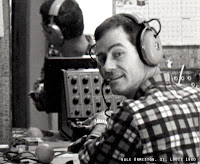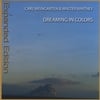For my friends who’ve been following my
music from the beginning, I wanted to note a milestone: it’s been 31 years since the release of my
first record, Submergings, on
glorious vinyl in December 1981.
Produced more than two years after I graduated from film school, Submergings was a low-tech cinematic sci-fi-inspired
home-studio brew of tape delay, analog synthesizers, cassette loops, found
sounds, and guitars. Dark Ambient might
be the contemporary genre to classify the music in today’s market.
The Record Geek
My interest in record production came out
of my teenage passion for music and record collecting. The role that albums played in popular
culture was unprecedented for many years and often generated headlines. Miles Davis or The Beatles, for example,
could trigger a shift in both social and music landscapes from a given album
release. It’s hard to imagine this
today. I was also drawn to the
narrative of an artist’s life as documented in their output of recordings, and
especially the mythology surrounding the behind-the-scenes world of studio
production.
When I began to explore making a record
of my own music, I knew very little about studio production, let alone the
production chain required to get pressed vinyl into a jacket and record store. St. Louis had a vibrant music
scene in 1980, as it does today, but there was no recording industry there at
that time. The only media professionals
in town were old-school industrial audio and film houses where LP production
was rare and often limited to vanity pressing for churches and schools. Making a record, like any media production,
is not one thing; it’s music, performance, recording, graphics, writing and
printing all brought together. I
understood this from film school, but I had to teach myself both a new art and
its industry.
In the meantime, I saw a wave coming
in. In major cities around the country,
independent music was taking off. Young
artists and bands were making vibrant new recordings in small and home studios,
and selling their records through a growing network of independent
distributors. College radio was
exploding with this new indie sound and major labels found themselves pushed
aside on the airwaves. I wanted to be
part of this new scene.
How Not To Do Business
There was a promising start when I was
recruited by an old family friend to open a record store. With little more than a few crates of used
LPs and a booth in a local farmer’s market, my friend, his business partner,
and I soldiered through a year of street vendor sales, slowly buying and
building an inventory of LPs. They were the core of the operation, but I was
the associate and provided, on call, whatever labor and support they
needed. Other friends came and went
through the year, but I was the only one who believed in the prospect to stick
it out all the way. I learned a lot that
year, and they learned a few things from me as well. In return for my loyalty, the owner promised me a job.
One day, I overheard a shop owner in our
neighborhood mention that his business was closing. The location was next to a movie theater,
near a university campus in the heart of a resurging business district. We couldn’t have asked for a better location. I passed this information on to my friend who
called the city, and was able to secure this prized storefront before it went
up for bid.
Within weeks, the record store was open and running. I was thrilled at the prospect of working in the record store. As business heated up, I proposed starting a record label, and envisioned the store becoming a hub for local bands, record distribution, and music marketing. The owner was enthusiastic and his intentions were genuine, but he had his hands full, understandably. Cash flow was his first priority, followed by carrying his dysfunctional business partner, a former college running buddy, who by his own admission, had been a petty drug dealer and believed this to be a worthy business model. He dragged this concept through the operation, and no matter how much personal baggage the partner unloaded on me or our customers, the owner always covered for him. At one point, when money was particularly low, I persuaded my father to invest in the business, and he loaned the partners a thousand dollars. Later, in private, the partners expressed not their gratitude, but their resentment at having to pay it back.
Once the doors opened, a gap began to open up between what I was promised and my actual place in the business. The owner, who for a year couldn’t keep me busy enough as his future employee, now had no imagination when it came to what my job actually was, even after both partners began taking salaries. My time, labor, connections and inventory were always welcomed with open arms, but ultimately regarded as donations rather than business transactions. I went from associate, to budget contractor, to resident volunteer. By this point partners no longer included me in meetings, and when I asked the owner to discuss regular hours and a salary, he waved me off as being unreasonable.
Ironically, I was still valuable enough that the owner called me behind his partner’s back to offer work under the table, but the nickel and diming was endless. A week after I left, there were three new employees behind the counter. Looking back now, things worked out as they probably should have, though we could have done a lot of good work together. In the end, they got what they wanted and I got what I wanted.
Within weeks, the record store was open and running. I was thrilled at the prospect of working in the record store. As business heated up, I proposed starting a record label, and envisioned the store becoming a hub for local bands, record distribution, and music marketing. The owner was enthusiastic and his intentions were genuine, but he had his hands full, understandably. Cash flow was his first priority, followed by carrying his dysfunctional business partner, a former college running buddy, who by his own admission, had been a petty drug dealer and believed this to be a worthy business model. He dragged this concept through the operation, and no matter how much personal baggage the partner unloaded on me or our customers, the owner always covered for him. At one point, when money was particularly low, I persuaded my father to invest in the business, and he loaned the partners a thousand dollars. Later, in private, the partners expressed not their gratitude, but their resentment at having to pay it back.
Once the doors opened, a gap began to open up between what I was promised and my actual place in the business. The owner, who for a year couldn’t keep me busy enough as his future employee, now had no imagination when it came to what my job actually was, even after both partners began taking salaries. My time, labor, connections and inventory were always welcomed with open arms, but ultimately regarded as donations rather than business transactions. I went from associate, to budget contractor, to resident volunteer. By this point partners no longer included me in meetings, and when I asked the owner to discuss regular hours and a salary, he waved me off as being unreasonable.
Ironically, I was still valuable enough that the owner called me behind his partner’s back to offer work under the table, but the nickel and diming was endless. A week after I left, there were three new employees behind the counter. Looking back now, things worked out as they probably should have, though we could have done a lot of good work together. In the end, they got what they wanted and I got what I wanted.
DIY
 On my own, I began making fresh
connections around town to start my record label. I had production and management experience,
but I needed to teach myself to run a label from one end to the other. Mentoring is often described as a single
person passing on knowledge, but one can also be mentored by a group of people,
with specific skills offered by each. To
accomplish this summation of knowledge, I gathered a team of specialists.
On my own, I began making fresh
connections around town to start my record label. I had production and management experience,
but I needed to teach myself to run a label from one end to the other. Mentoring is often described as a single
person passing on knowledge, but one can also be mentored by a group of people,
with specific skills offered by each. To
accomplish this summation of knowledge, I gathered a team of specialists.
The first was Greg Glazier, a professional
recording engineer, who produced local media ads. Music wasn’t his thing, but he was willing to
work with me in his “state-of-the-art” 8-track commercial recording studio. Greg was generous with his knowledge and
showed me the ropes of studio production and multi-track recording.
The second partner was St. Louis rock guitar hero David Udell. David and his band
mates called Earwacks (aka Wax Theatrix) had been veterans of the
local music scene since they were teenagers.
David also worked in my neighborhood and we became friends. We enjoyed much of the same music and I told him
about the record project. After some cajoling; he agreed to play on it. A week later, on a rainy morning, David and
his friend Danny Fojammi arrived at Greg’s studio with his gear and a ready
supply of Coke-a-Cola and cigarettes.
David set up his amp in the sound booth and listened to the tracks I had
prepared. The music was little more than
a sound collage at that point, but David plugged in and played beautifully
against all the electronic incomprehensibleness. I was more than satisfied, but David, I
discovered was a perfectionist and skeptical about the results. So skeptical in fact, that he insisted on
being credited on the album under the name Phil Neon.
The third and vital collaborator was the
artist Gale Ormiston. Gale was a
professional modern dancer and educator who had been a member of The Alwin
Nikolais Dance Company in New York. The Nikolai Dance Company had been pioneers
in modern dance since the 1950s, and also in producing electronic music
scores. I had met Gale several years
earlier during his residency at the college I attended and he had recently
moved to St. Louis to teach at Washington University. Gale understood what I was attempting to do
with the project, and he became a co-producer.
He also provided the keyboard for the recording, the legendary Korg
MS-20 synthesizer. The MS-20 was one of
the most amazing, yet completely user-unfriendly, analog synthesizers ever
made. Its array of knobs and plugs
resembled a time-bomb more than a musical instrument. But Gale was never intimidated, and he never
failed to deliver sounds that were out of this world. Cigarette in one hand, knob twisting with the
other, he worked the dials, as if tuning in a distant alien radio signal.
Two other partners contributed to the
project as well. They were graphic
artist Jane Clanton and photographer Mike Bono. They not only created the album cover, but
both were generous with their time and knowledge of print production.
The Long Home Stretch
Over several months I did various temp
jobs to pay for production and studio time.
The music took shape as Greg and I mixed the five tracks for the album. A
local record plant pressed the LPs and Submergings
became the first release on Multiphase Records, December 1981. The success was beyond my expectations. By the following spring, print reviews
appeared nationally and the album was charting on college radio. Picked up by several distributors, the LP was
placed the record in stores across the U.S.
Over the next few years, more LP releases
followed with an expanding circle of musicians.
The momentum continued with reviews in magazines like Musician, Billboard, Keyboard and a
signing proposal from Vanguard Records.
By the mid-1980s, the independent music scene was booming, but the
emphasis was on indie rock. Our niche
label of instrumental music struggled in a rapidly crowding market. I was working for Streetside Records in 1986
when compact discs arrived like locusts, blowing vinyl off the record store shelves
in a matter of weeks. This was happening everywhere. My label suffered as LP sales
fell off and many indie distributors went out of business without paying their
bills or returning our inventory.
RIP 33RPM
As a small label, Multiphase was
vulnerable, but resilient enough to bounce back. It took another three years, but I was able to
re-launch Multiphase with our first CD release, Primitive Earth in 1989 - the first music CD released by an
independent artist in St. Louis. Today,
the partial comeback of vinyl LPs has been profitable for some, but ironic as
far as I’m concerned. I see references to
Submergings on music blogs, and used
copies selling for collector’s prices. I
can only think of a certain box in my garage, covered in dust and containing my
few remaining LPs. Thirty years is a
long time to break even.














1 comment:
Wish you'd make the Urban Cabaret samplers available. Or any of the other early Multiphase recordings, like the early Delay Tactics records!
Wish I could find more recordings by Joan Bouise. Her piece on the first Urban Cabaret sampler was stupendous!
Post a Comment